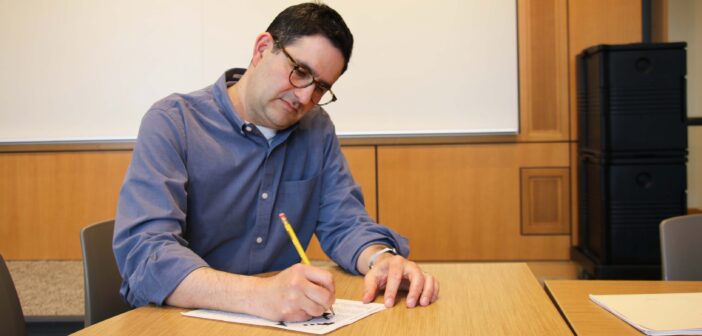Can you guess the five-letter word from the crossword clue “early number?” It’s a play on words, with the word “number” needing to be interpreted as “numb-er.”
The answer? “Ether,” which is a liquid that was used as an early numbing agent.
This clever hint was created by Larry Snyder, a Lehigh industrial and systems engineering professor. It was one of his personal favorites in his crossword puzzle that was published in The New York Times’ edition of its daily crossword game on Feb. 23.
The process of his puzzle being selected by the pinnacle of internet-hosted crosswords was far from a lucky chance. The mathematically-minded Snyder has been making puzzles for the past 20 years.
Snyder began by creating brain teasers for his students and coworkers, and since then, he has published two books of various logic puzzles.
Every creator’s process of constructing a puzzle is special. Snyder, like many puzzle makers, uses crossword-construction software to generate possible word choices that fit the grid and are easily built upon. However, he ultimately hand-picks each word, sometimes changing one multiple times before the puzzle is completed.
“Your choice of what word you want is where your voice as a constructor comes through,” Snyder said.
Many of Snyder’s puzzles showcase words related to topics he’s interested in, including math, food and movies. By completing the puzzle, his solvers get a glimpse of his personality.
Snyder said he liked solving logic and word puzzles as a kid. However, creating his own puzzles was a hobby that came later.
“I didn’t think about the creative process behind puzzle-making until I started working at Lehigh in 2003 when I would adapt puzzles to keep my engineering students busy,” Snyder said.
Snyder said his puzzle-making increased when he worked part-time at a start-up consulting firm. His boss tasked him with writing weekly puzzles for employees to solve. These puzzles included mathematical brain-teasers, logic puzzles and a few crosswords.
Following positive feedback from employees, his boss requested a book of puzzles to distribute to clients as a holiday present. Thus, Snyder’s hobby grew as he created and published two whole books full of logic puzzles.
Snyder’s interest in crosswords grew once more during the pandemic when he caved and spent $40 on a New York Times games subscription. He began solving puzzles every day before diving head-first into creating his own.
Puzzle construction is an intricate task, Snyder said.
He begins by laying out the grid, selecting the black box locations and using software to generate word possibilities. Crossword outlets, like the New York Times, often have specific constraints on the format of puzzles. These rules include making the puzzles symmetric and not having one- or two-letter answers.
Crosswords are typically constructed by choosing the answer words prior to forming clues. Snyder said this is because word selection is a back-and-forth process, and each word has implications for the entire puzzle.
“It could be that you want to put the word ‘automobile’ in one slot, but there wouldn’t be words that could cross it, and then words that cross them, and words that could cross them to get the whole puzzle filled in,” Snyder said.
In total, Snyder said puzzles can take anywhere from a few hours to a few months to create. His New York Times puzzle took the latter part of that time frame.
He said that puzzle was particularly difficult to craft because the grid had fewer words and fewer black squares, making it harder to fill in.
Snyder’s puzzles have been published in various other media outlets, including The Los Angeles Times, The Philadelphia Inquirer and The Boston Globe. His latest puzzle debuted in USA Today on April 8.
While Snyder has found success with his puzzles, he still describes the passion as a hobby and spends his time on many other endeavors as well.
At Lehigh, Snyder is the Harvey E. Wagner Endowed Chair in manufacturing systems engineering. He has conducted research on supply chain management and energy systems and is a student advisor.
“He is involved in so many things, but he still goes above and beyond to meet with his students outside of our weekly meetings to make sure we are on track,” Brendan Ruskey, one of Snyder’s doctoral advisees, said. “He is passionate, caring and hard-working.”
Ruskey, whose dissertation is on political redistricting, appreciates the freedom and empowerment Snyder gives him to study a topic he is interested in.
Snyder also co-teaches a class with his wife, Professor Suzanne Edwards, called “Algorithms and Social Justice.” The course content uniquely combines women, gender and sexuality studies with industrial and systems engineering.
Gabriella Rub, ‘24, took this class with Snyder and Edwards. She said Snyder is extremely intelligent, always curious, easy to talk to and, above all, kind.
“For him to be selected for the crossword puzzle is the epitome of who he is, what he is interested in and how he likes to learn and teach,” Rub said.
Snyder’s co-worker and research partner, Shalinee Kishore, said beyond being intelligent, Snyder knows how to connect with people. Kishore reflected on when she and Snyder would visit different companies to present research opportunities to them.
“I was always so impressed with his ability to connect to people in that world and so easily,” Kishore said. “I think I learned from him and I became better at it.”
Outside of Lehigh, Snyder enjoys spending time with his two kids, aged 12 and 15. He is an avid bird-watcher and photographer, and he enjoys taking pictures for his daughter’s high school theater shows.
Snyder is a man of many interests. In his New York Times puzzle, crossword players all around the world received a glimpse into his multifaceted mind.






Comment policy
Comments posted to The Brown and White website are reviewed by a moderator before being approved. Incendiary speech or harassing language, including comments targeted at individuals, may be deemed unacceptable and not published. Spam and other soliciting will also be declined.
The Brown and White also reserves the right to not publish entirely anonymous comments.